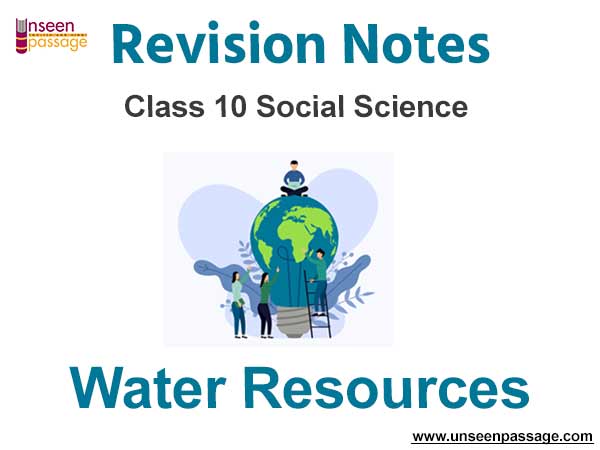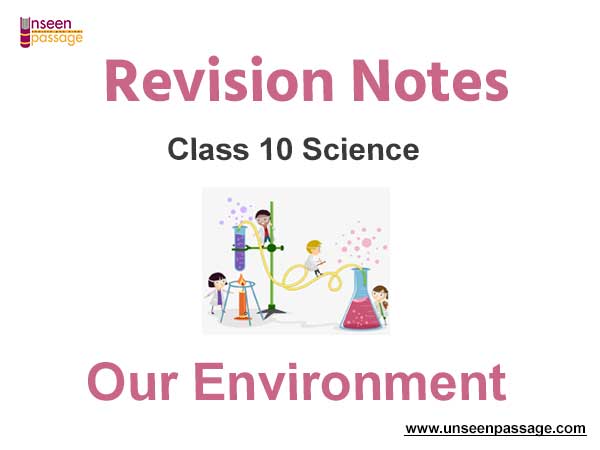Water Resources Notes for Class 10 Social Science
Following are Water Resources Notes for Class 10 Social Science. These revision notes have been prepared by expert teachers of Class 10 Social Science as per the latest NCERT, CBSE, KVS books released for the current academic year. Students should go through Chapter 3 Water Resources concepts and notes as these will help you to revise all important topics and help you to score more marks. We have provided Class 10 Social Science notes for all chapters in your book. You can access it all free and download Pdf.
Chapter 3 Water Resources Notes Class 10 Social Science
Key Points and Definitions
1.) 96.5% of the total volume of world’s water is estimated to exists as oceans and only 2.5% as freshwater.
2.) Most of the rivers of India especially river tributaries or smaller ones have become poisonous/toxic streams due to pollution.
3) River Basin-Total irrigated area by the main river and it’s tributaries.
4) “Narmada Bachao Andolan”{Save Narmada Movement}-A movement against the Sardar Sarovar Dam being built across the Narmada river.
5) Palar Pani-Stored rainwater in tankas considered as the purest form of natural water in the dried areas of Rajasthan.
6) Underground Water-The water which is collected in the layers and rock pores below the soil.
7) Rain water harvesting-Collecting the rain water in dug wells and reuse of it.
8) Hydroelectricity(hydel power)-Electricity generation from the flowing water/rivers by throwing it from height.
9) Waterfall-In the middle of the river valley fall of a stream from a height.
10) Dam-A dam is a barrier across flowing water that obstructs, directs or retards the flow, often creating a reservoir, lake or impoundment.
11) Multi-purpose projects-Many uses of the impounded water are integrated by making a dam.
12) Multinational companies(MNCS)-Those companies whose industrial organisations work more than in a single nation and they invest capital in many countries to earn maximum profits.
13) Bamboo Drip Irrigation System-Tapping stream and spring water for irrigation by using bamboo pipes.
Very Short Answer Type Questions
Question. What was the main purpose of starting multi purpose projects after the independence of India?
Ans. (i) Development of Agriculture and the village economy.
(ii) Rapid industrialisation
(iii) Growth of the urban economy.
Question. By which name the roof top water harvesting is called in Rajasthan?
Ans. Tanka
Question. What are Khadins’ and ‘Johads’?
Ans. Rain fed storage structures to collect the water in arid and semi-arid regions.
Question. How much water is there in the world out of total volume for the use of humans?
Ans. 2.5%
Question. In which state of India the roof top rainwater harvesting structure has been made compulsory with legal provisions?
Ans. Tamil Nadu
Question. Give an example from India where there is a sufficient rainwater yet there is a scarcity of drinking water?
Ans. Shillong the capital of Meghalaya.
Question. Name the state and the river on which the Tehri Dam Project situated?
Ans. On Bhagirathi river in Uttrakhand.
Question. In which state and across which river the Salal Project is located?
Ans. On Chenab river in Jammu & Kashmir.
Question. Write the two causes of water scarcity?
Ans. (i) The growing needs of the increasing population.
(ii) The unequal distribution of water or access to it.
Question. What are Guls’ or ‘Kuls’?
Ans. The diversion channels built in the mountainous regions of Western Himalayas.
Short/Long Answer type Questions
Question. Why the scarcity of water is increasing in our country day by day? Enlist the reasons behind it?
Ans. (i) India is a country of Monsoon climate. Some time due to the failure of Monsoon the scarcity of water Increases.
(ii) The rapid growth in the demand of irrigation water.
(iii) Due to the industrial activities downfall of underground water.
(iv) Growing pressure on the water resources due to the pace of urbanisation.
(v) To meet the needs of the growing population.
Question. How does an abandoned dugwell can be re-filled by the rain water?
Ans. (i) Roof top rain water is collected using a PVC pipe
(ii) Filtered using sand and bricks
(iii) Underground pipe takes water to sumps for immediate usage
(iv) Excess water from the sump is taken to the well.
(v) Water from the well recharges the underground
(vi) Later take water from the well.
Question. State the reasons behind the development of big dams in India in recent years?
Ans. (i) Excessive sedimentation
(ii) Water logging
(iii) Soil erosion
(iv) Sudden floods
(v) Large-scale deforestation
(vi) Extinction of species
(vii) Displacement of people
(viii) Tribal communities losing their livelihood.
(ix) Big dams have been unsuccessful in controlling floods at the time of excessive rainfall. The release of water from the dam during heavy rainfall worsens the situation.
(x) Dams cause earthquakes, waterborne diseases and pollution due to excessive use of water.
Question. Write a short note on ‘Narmada Bachao Andolan’?
Ans. A movement against the Sardar Sarovar Dam being built across the Narmada river in Gujarat.
(i) Organised by Non Governmental Organisation(NGO)
(ii) Mobilised tribal people, farmers, environmentalists and human rights activists.
(iii) It originally focused on the environmental issues related to trees that would be submerged under the dam water.
(iv) Later re-focused the aim to get full rehabilitation of displaced people.
Question. What is multi purpose river valley project? State different purposes of these projects?
Ans. Building dams on a river and achieving many purposes is called Multi-purpose projects. Some of these are-
(i) Irrigation
(ii) Electricity generation
(iii) Water supply for domestic and industrial uses
(iv) Inland navigation and tourism
(v) Flood control
(vi) Fish breeding.
Question. Why does the water need to be conserve and managed despite being a renewable resource?
Ans. (i) There is only 2.5% fresh water in the world.
(ii) Overexploitation of water resources.
(iii) Growing population, greater demand and unequal access.
(iv) Increasing Urbanization.
(v) Due to industrialisation.
Question. What is Rain Water Harvesting? Write any two methods of Rain Water Harvesting popular in different regions of India?
Ans. (i) A technique in which rain water is filled in empty places,tanks in houses, abandoned dugwell etc.Later it is used.
(ii) In hill and mountainous regions, people built diversion channels like ‘guls’ and ‘kuls’ for irrigation.
(iii) ‘Rooftop rain water harvesting’ was commonly practiced to store drinking water ,particularly in Rajasthan.
(iv) In the flood plains of Bengal, people developed inundation channels to irrigate their fields.
(v) Rain fed storage structures like the ‘Khadins’ and ‘Johads’ in arid and semi-arid regions.
Question. How the industrialisation and urbanisation are responsible for the water scarcity?
Ans. (i) Rapid industrialisation after the independence.
(ii) Due to ever-increasing number of industries excess use of fresh water.
(iii) Multiplying urban centres with large and dense population and urban lifestyles have added to water and energy requirements.
(iv) Overexploitation of water resources in cities as well as in villages.
Question. Why Jawaharlal Nehru proudly proclaimed dams as the ‘temples of modern India’? Enlist the advantages from the dams?
Ans. There are many advantages of Dams. These projects integrate the development of agriculture with industries therefore Nehru ji called them the temples of modern India.
Advantages-
(i) Irrigation
(ii) Electricity generation
(iii) Water supply for domestic and industrial uses
(iv) Flood control
(v) Recreation and Tourism
(vi) Fish breeding
Question. “It is said if there will be any third world war it will be because of water scarcity.”Keeping in mind the example of water scarcity in Cape Town(South Africa), explain the causes responsible for the water scarcity in the world?
Ans. (i) De forestation(Deserts)
(ii) Metropolitan cities
(iii) Growing population
(iv) Increasing Urbanisation
(v) Industrialization
(vi) Agriculture
(vii) Excess use/misuse of water
(viii) Pollution
(ix) Irrational distribution and consumption
(x) Decreasing level of under ground water.
(xi) Uncertainty of Monsoon.etc.
Question. Describe how modern adaptations of traditional rainwater harvesting methods are being carried out to conserve and store water?
Ans. (i) Rooftop Rainwater Harvesting
(ii) ‘Guls’ or ‘Kuls’
(iii) Inundation channels
(iv) Rainfed storage structures
(v) Tank or Tankas
(vi) Bamboo Drip Irrigation System



